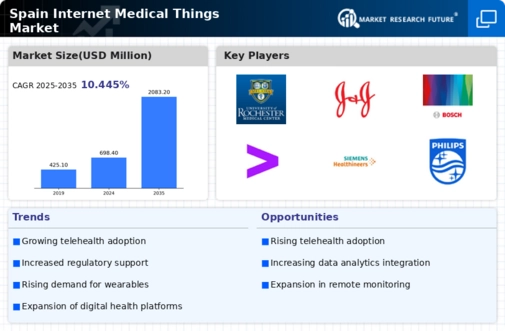Government Initiatives and Funding
Government initiatives and funding significantly influence the internet medical-things market in Spain. The Spanish government has recognized the importance of digital health solutions and is actively promoting their adoption through various programs and funding opportunities. For example, recent investments in telemedicine infrastructure and digital health initiatives aim to enhance healthcare accessibility and efficiency. In 2025, the government allocated approximately €200 million to support the development of innovative health technologies. Such financial backing not only encourages startups and established companies to innovate but also fosters collaboration between public and private sectors. This supportive environment is likely to accelerate the growth of the internet medical-things market, as stakeholders leverage government resources to enhance their offerings and expand their reach.
Increasing Health Awareness Among Consumers
The internet medical-things market in Spain is witnessing a shift in consumer behavior, characterized by increasing health awareness. As individuals become more proactive about their health, there is a growing demand for tools that facilitate self-monitoring and health management. Surveys indicate that over 60% of Spaniards are now using health-related applications or devices to track their fitness and wellness. This trend is further fueled by the rise of health-conscious lifestyles and the desire for personalized healthcare solutions. Consequently, companies operating in the internet medical-things market are adapting their offerings to meet these evolving consumer preferences. By providing user-friendly and accessible health technologies, businesses can capitalize on this trend, potentially leading to increased market penetration and customer loyalty.
Rising Demand for Remote Patient Monitoring
The internet medical-things market in Spain experiences a notable surge in demand for remote patient monitoring solutions. This trend is driven by an increasing prevalence of chronic diseases, which necessitates continuous health tracking. According to recent data, approximately 30% of the Spanish population suffers from chronic conditions, leading to a heightened need for effective monitoring tools. Remote monitoring devices enable healthcare providers to collect real-time data, facilitating timely interventions and improving patient outcomes. Furthermore, the convenience of these solutions appeals to both patients and healthcare professionals, as they reduce the need for frequent hospital visits. This growing demand for remote patient monitoring is likely to propel the internet medical-things market forward, as stakeholders invest in innovative technologies to enhance patient care and streamline healthcare delivery.
Technological Advancements in Medical Devices
Technological advancements play a pivotal role in shaping the internet medical-things market in Spain. Innovations such as artificial intelligence, machine learning, and advanced sensor technologies are revolutionizing medical devices, making them more efficient and user-friendly. For instance, AI-driven diagnostic tools are becoming increasingly prevalent, allowing for quicker and more accurate assessments of patient conditions. The integration of these technologies not only enhances the functionality of medical devices but also improves data accuracy and patient engagement. As a result, healthcare providers are more inclined to adopt these advanced solutions, thereby driving growth in the internet medical-things market. The continuous evolution of technology suggests that the market will likely witness further innovations, fostering a competitive landscape that prioritizes patient-centric care.
Integration of Internet of Things (IoT) in Healthcare
The integration of Internet of Things (IoT) technologies is transforming the internet medical-things market in Spain. IoT devices enable seamless connectivity between medical equipment, healthcare providers, and patients, facilitating real-time data exchange and improved decision-making. This interconnectedness enhances the efficiency of healthcare delivery, as providers can monitor patients remotely and respond promptly to any changes in their condition. The market for IoT-enabled medical devices is projected to grow significantly, with estimates suggesting a CAGR of around 25% over the next five years. This growth is indicative of the increasing reliance on IoT solutions to enhance patient care and operational efficiency. As healthcare systems continue to embrace IoT technologies, the internet medical-things market is likely to expand, driven by innovations that prioritize connectivity and data-driven insights.

















Leave a Comment